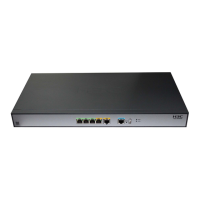529
Flow
Information about the data flow protected by the IPsec tunnel, including
source IP address, destination IP address, source port, destination port,
and protocol.
as defined in ACL 3001
Range of data flow protected by the IPsec tunnel that is established
manually. This information shows that the IPsec tunnel protects all data
flows defined by ACL 3001.
encapsulation-mode
Use encapsulation-mode to set the encapsulation mode that the security protocol uses to
encapsulate IP packets.
Use undo encapsulation-mode to restore the default.
Syntax
encapsulation-mode { transport | tunnel }
undo encapsulation-mode
Default
IP packets are encapsulated in tunnel mode.
Views
IPsec transform set view
Predefined user roles
network-admin
Parameters
transport: Uses the transport mode for IP packet encapsulation.
tunnel: Uses the tunnel mode for IP packet encapsulation.
Usage guidelines
IPsec supports the following encapsulation modes:
• Transport mode—The security protocols protect the upper layer data of an IP packet. Only the
transport layer data is used to calculate the security protocol headers. The calculated security
protocol headers and the encrypted data (only for ESP encapsulation) are placed after the
original IP header. You can use the transport mode when end-to-end security protection is
required (the secured transmission start and end points are the actual start and end points of
the data). The transport mode is typically used for protecting host-to-host communications.
• Tunnel mode—The security protocols protect the entire IP packet. The entire IP packet is used
to calculate the security protocol headers. The calculated security protocol headers and the
encrypted data (only for ESP encapsulation) are encapsulated in a new IP packet. In this mode,
the encapsulated packet has two IP headers. The inner IP header is the original IP header. The
outer IP header is added by the network device that provides the IPsec service. You must use
the tunnel mode when the secured transmission start and end points are not the actual start and
end points of the data packets (for example, when two gateways provide IPsec but the data
start and end points are two hosts behind the gateways). The tunnel mode is typically used for
protecting gateway-to-gateway communications.
The IPsec transform sets at both ends of the IPsec tunnel must have the same encapsulation mode.
Examples
# Configure the IPsec transform set tran1 to use the transport mode for IP packet encapsulation.

